Overclocking
First of all, we are exploring the limits. To make sure that we don't run in thermal limits, because Intel still relies on the tiresome thermal paste between Die and IHS, we initially use the chiller again and cool the IHS with a constant 20°C. We reach the 5 GHz mark without any problems, which is not surprising after the experience with Kaby Lake. With 5.1 GHz Windows started and two games were running, but then Cinebench was already finished.
In this context, we would like to draw attention to the possibilities of manual load-line calibration, also with regard to the temperatures to be analyzed later. Depending on the board, you can use different levels or Select preferences or manually experiment with the voltages. This allows the core voltage to be significantly lowered under full load without sanoining performance as long as the chip plays along. With our tested board, this means with Prime95 and standard clock that the effective voltage can then be between 1.28 volts maximum and 1.18 volts, which means almost 8°C less temperature on the package.
However, it is important to note that many memory kits with a load line set too low come into the swim and become unstable. A crash is then the logical consequence. Of course, this depends heavily on CPU quality. This then concerns our overclocking with 5.0 GHz, which we did not really get there for the long term. While all games and most workstation applications ran for hours, Creo3 and some HPC applications crashed in just a few minutes.
One should therefore not be blinded by the supposed overclocking successes of the i7-8700K from time to time above the 5 GHz mark, because often enough these values have not been tested over long time and with appropriate applications. In case of doubt, it is better to take back 100 MHz and put stability in the foreground.
If we also look at our diagram with the comparison of power consumption and performance, then we already see the kink, which starts from approx. 4.8 GHz. While the power consumption continues to increase at higher clock rates, the performance is already starting to stagnate:
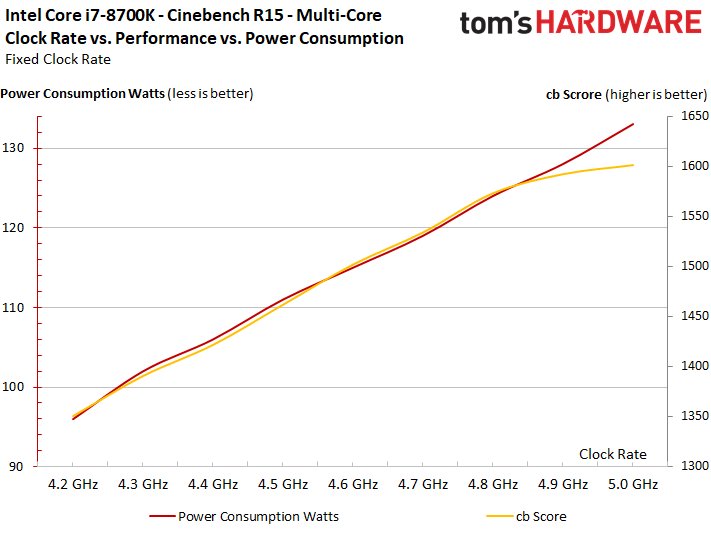
Power consumption
You don't see any really dramatic differences in the Idle, although the Core i7-8700 is slightly above the K version. Nothing dramatic and all the other CPUs are still within the limits of what we were able to measure before. The fact that the Ryzen 7 sometimes absorb significantly more is probably also due to their somewhat too high idle time.
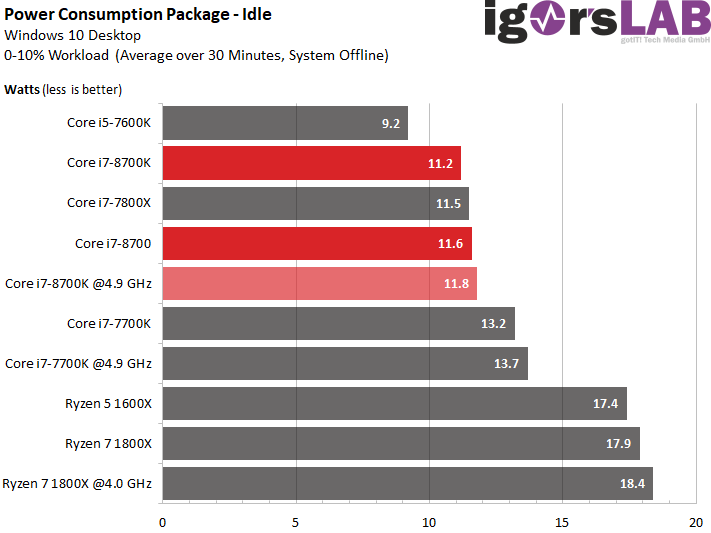
The average value of a typical application with 2D and 3D load components then coincides nicely with the actual measured performance values for the two new Intel CPUs.
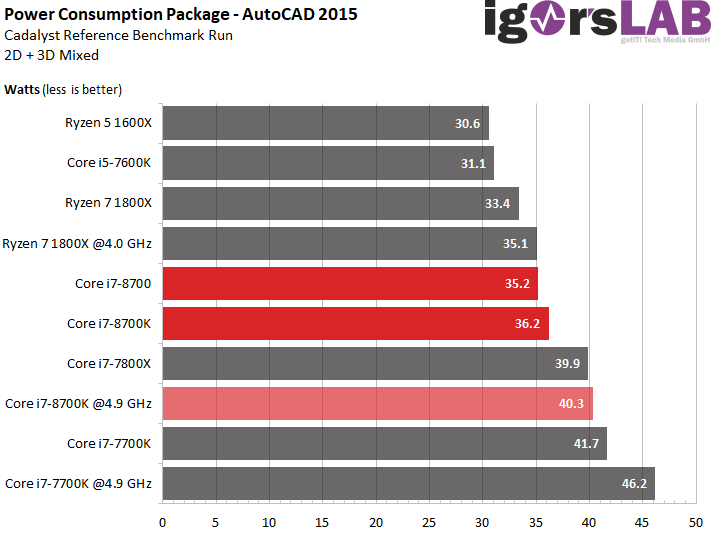
In the gaming loop, both CPUs are then almost the same, which should have looked different on paper, but it is clear from the phenomenon that has been mentioned often enough that the Core i7-8700 often boosts at least as high as the core at lower loads. i7-8700K. The thing with the decimal point then almost tends towards measuring tolerance. And we also found that the Core i7-8700K very often has up to 0.1 volts more, although it did not always act faster than the Core i7-8700.
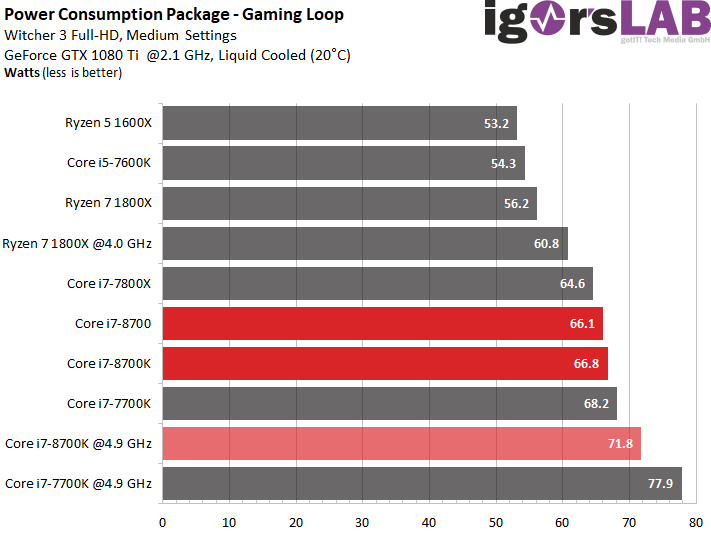
In the stress test with AVX you have the usual distance again, if you let the CPU on all cores drive the maximum turbo clock. Instead of the 110 watts when rendering without and plentiful 133 watts with overclocking to 5 GHz, AVX without offset lets the whole thing soar up to just under 170 watts, whereby the Core i7-8700K with 4.9 GHz already started to run into the thermal limit (package) – despite Chiller. Thanks to the loaus-like thermal paste.
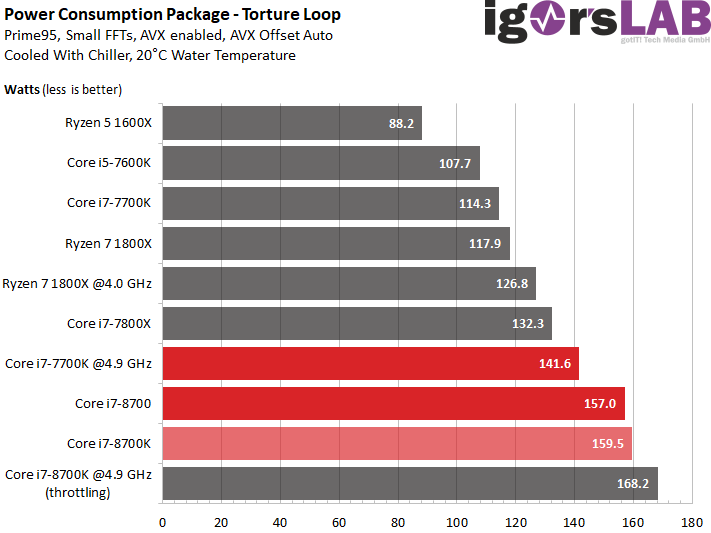 Temperatures
Temperatures
The good news in advance: if you are not rendering for hours or playing Prime95, you would theoretically even come comfortably over the 4.8 GHz mark with a very good air cooler – assuming a well-ventilated housing. Here, the fun brake in the form of Intel's thermal paste is already limited, but it is possible.
The following curves show that an AiO can still keep the overclocked Core i7-8700K just below the first thermal limitations, despite fully inflated core voltage and after 20 minutes of warm-up time. A good air cooler should be able to do the same if you don't operate the computer in the summer-heated attic.
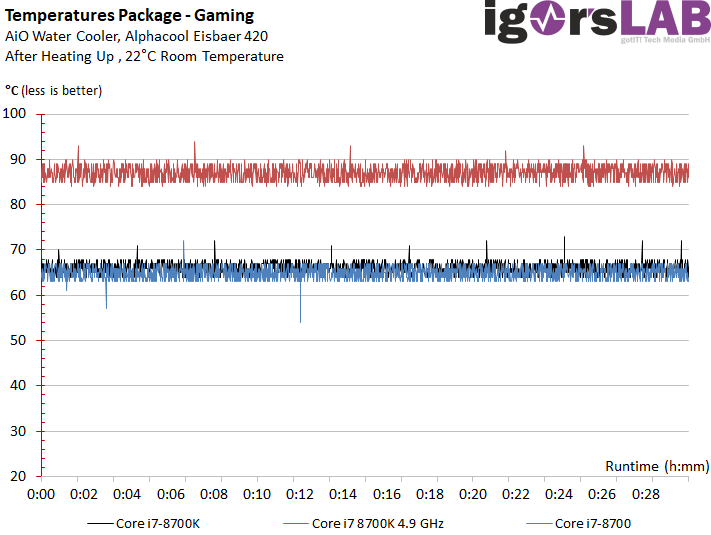
Under full load, it will then become scarce despite Chiller for the overclocked CPU. Even though we were only able to measure about 170 watts in the average, the partial throttling prevents the peaks with up to well over 180 watts from being consistently attached. At this point, the most potent water cooling fails.
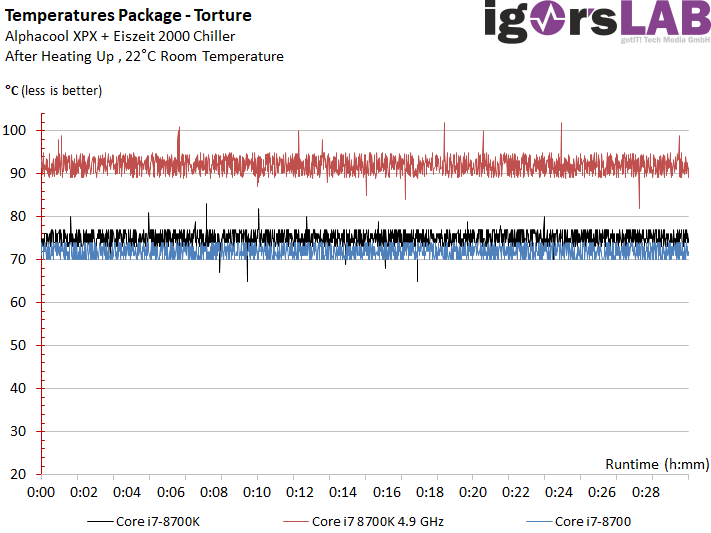
Intermediate conclusion
It's amazing what they can swallow a small CPU if you just provoke them properly. Nevertheless, the Core i7-8700 and 8700K are relatively easy to cool, even with air. This works really well with the Core i7-8700K even when overclocked, as long as you don't render for hours or even use AVX-based applications. Then you should already think about at least an AiO water cooling.
- 1 - Einführung und Test-Setup
- 2 - Chipsatz, Mainboard und Test-Setup
- 3 - 3DMark, VRMark, Civilization AI Test
- 4 - Ashes of the Singularity: Escalation
- 5 - Battlefield 1
- 6 - Civilization IV
- 7 - Warhammer 40K: Dawn of War III
- 8 - Project Cars
- 9 - Far Cry Primals
- 10 - Hitman (2016)
- 11 - Rise of the Tomb Raider
- 12 - DTP, Office, Multimedia und Kompression
- 13 - Workstation 2D- und 3D-Performance
- 14 - CPU-Computing und Rendering
- 15 - Wissenschaftlich-technische Berechnungen und HPC
- 16 - Übertaktung, Leistungsaufnahme, Temperaturen
- 17 - Zusammenfassung und Fazit
































Kommentieren